Equality Act 2010: Tackling Racial Discrimination in the Workplace
VerifiedAdded on 2022/12/14
|20
|6311
|87
Essay
AI Summary
This dissertation investigates the effectiveness of the Equality Act 2010 in tackling racial discrimination within the workplace. It begins with an introduction to the issue of racial discrimination, highlighting it as a persistent global problem. The essay then explores the development of anti-discrimination legislation, comparing previous laws like the Race Relations Act 1976 with the Equality Act 2010. It delves into employment legislation, outlining how the law protects employees. The essay also includes a comparison with the United States, analyzing similarities and differences in racial discrimination legislation. The core of the dissertation evaluates the Equality Act 2010's effectiveness, examining relevant cases and obstacles to resolving racial discrimination. It covers direct and indirect discrimination, harassment and victimisation. The conclusion assesses the Act's impact and offers recommendations. The study covers key aspects of employment law, including equal pay, employment rights, and health and safety, while also referencing the role of the Employment Tribunal and ACAS in resolving workplace disputes. The dissertation aims to determine whether the Equality Act 2010 has been successful in combating racial discrimination, and if improvements are needed.
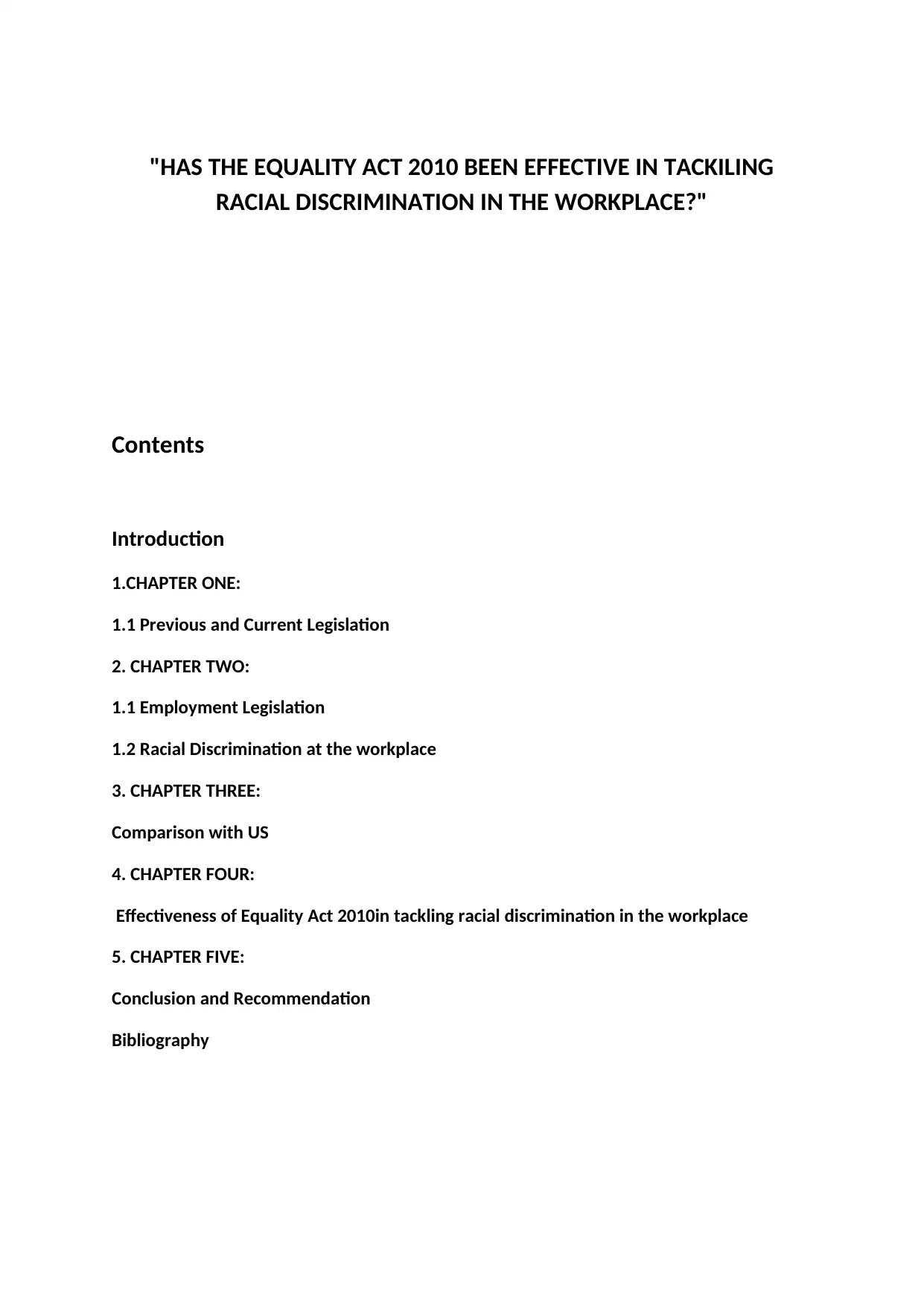
"HAS THE EQUALITY ACT 2010 BEEN EFFECTIVE IN TACKILING
RACIAL DISCRIMINATION IN THE WORKPLACE?"
Contents
Introduction
1.CHAPTER ONE:
1.1 Previous and Current Legislation
2. CHAPTER TWO:
1.1 Employment Legislation
1.2 Racial Discrimination at the workplace
3. CHAPTER THREE:
Comparison with US
4. CHAPTER FOUR:
Effectiveness of Equality Act 2010in tackling racial discrimination in the workplace
5. CHAPTER FIVE:
Conclusion and Recommendation
Bibliography
RACIAL DISCRIMINATION IN THE WORKPLACE?"
Contents
Introduction
1.CHAPTER ONE:
1.1 Previous and Current Legislation
2. CHAPTER TWO:
1.1 Employment Legislation
1.2 Racial Discrimination at the workplace
3. CHAPTER THREE:
Comparison with US
4. CHAPTER FOUR:
Effectiveness of Equality Act 2010in tackling racial discrimination in the workplace
5. CHAPTER FIVE:
Conclusion and Recommendation
Bibliography
Paraphrase This Document
Need a fresh take? Get an instant paraphrase of this document with our AI Paraphraser
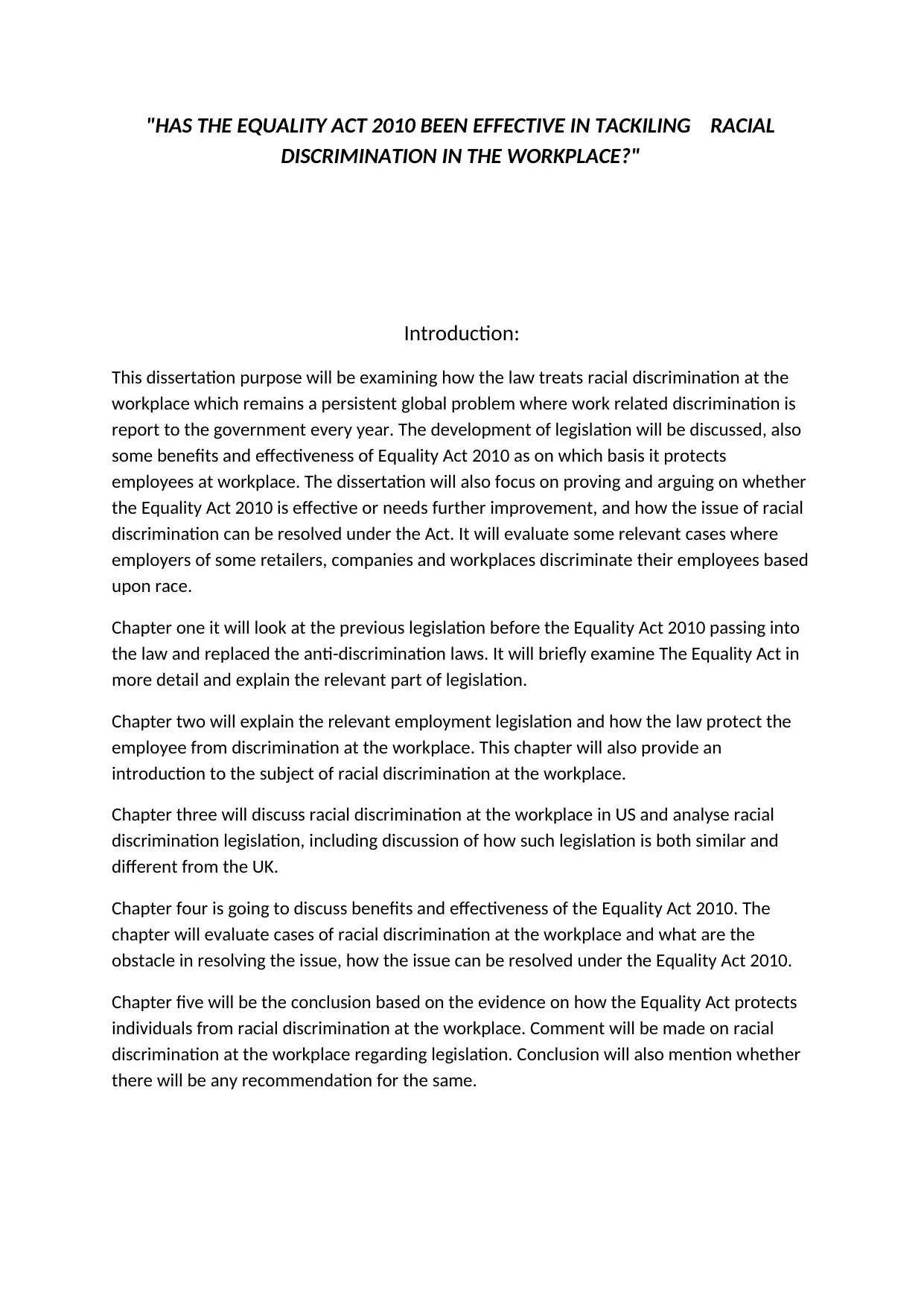
"HAS THE EQUALITY ACT 2010 BEEN EFFECTIVE IN TACKILING RACIAL
DISCRIMINATION IN THE WORKPLACE?"
Introduction:
This dissertation purpose will be examining how the law treats racial discrimination at the
workplace which remains a persistent global problem where work related discrimination is
report to the government every year. The development of legislation will be discussed, also
some benefits and effectiveness of Equality Act 2010 as on which basis it protects
employees at workplace. The dissertation will also focus on proving and arguing on whether
the Equality Act 2010 is effective or needs further improvement, and how the issue of racial
discrimination can be resolved under the Act. It will evaluate some relevant cases where
employers of some retailers, companies and workplaces discriminate their employees based
upon race.
Chapter one it will look at the previous legislation before the Equality Act 2010 passing into
the law and replaced the anti-discrimination laws. It will briefly examine The Equality Act in
more detail and explain the relevant part of legislation.
Chapter two will explain the relevant employment legislation and how the law protect the
employee from discrimination at the workplace. This chapter will also provide an
introduction to the subject of racial discrimination at the workplace.
Chapter three will discuss racial discrimination at the workplace in US and analyse racial
discrimination legislation, including discussion of how such legislation is both similar and
different from the UK.
Chapter four is going to discuss benefits and effectiveness of the Equality Act 2010. The
chapter will evaluate cases of racial discrimination at the workplace and what are the
obstacle in resolving the issue, how the issue can be resolved under the Equality Act 2010.
Chapter five will be the conclusion based on the evidence on how the Equality Act protects
individuals from racial discrimination at the workplace. Comment will be made on racial
discrimination at the workplace regarding legislation. Conclusion will also mention whether
there will be any recommendation for the same.
DISCRIMINATION IN THE WORKPLACE?"
Introduction:
This dissertation purpose will be examining how the law treats racial discrimination at the
workplace which remains a persistent global problem where work related discrimination is
report to the government every year. The development of legislation will be discussed, also
some benefits and effectiveness of Equality Act 2010 as on which basis it protects
employees at workplace. The dissertation will also focus on proving and arguing on whether
the Equality Act 2010 is effective or needs further improvement, and how the issue of racial
discrimination can be resolved under the Act. It will evaluate some relevant cases where
employers of some retailers, companies and workplaces discriminate their employees based
upon race.
Chapter one it will look at the previous legislation before the Equality Act 2010 passing into
the law and replaced the anti-discrimination laws. It will briefly examine The Equality Act in
more detail and explain the relevant part of legislation.
Chapter two will explain the relevant employment legislation and how the law protect the
employee from discrimination at the workplace. This chapter will also provide an
introduction to the subject of racial discrimination at the workplace.
Chapter three will discuss racial discrimination at the workplace in US and analyse racial
discrimination legislation, including discussion of how such legislation is both similar and
different from the UK.
Chapter four is going to discuss benefits and effectiveness of the Equality Act 2010. The
chapter will evaluate cases of racial discrimination at the workplace and what are the
obstacle in resolving the issue, how the issue can be resolved under the Equality Act 2010.
Chapter five will be the conclusion based on the evidence on how the Equality Act protects
individuals from racial discrimination at the workplace. Comment will be made on racial
discrimination at the workplace regarding legislation. Conclusion will also mention whether
there will be any recommendation for the same.
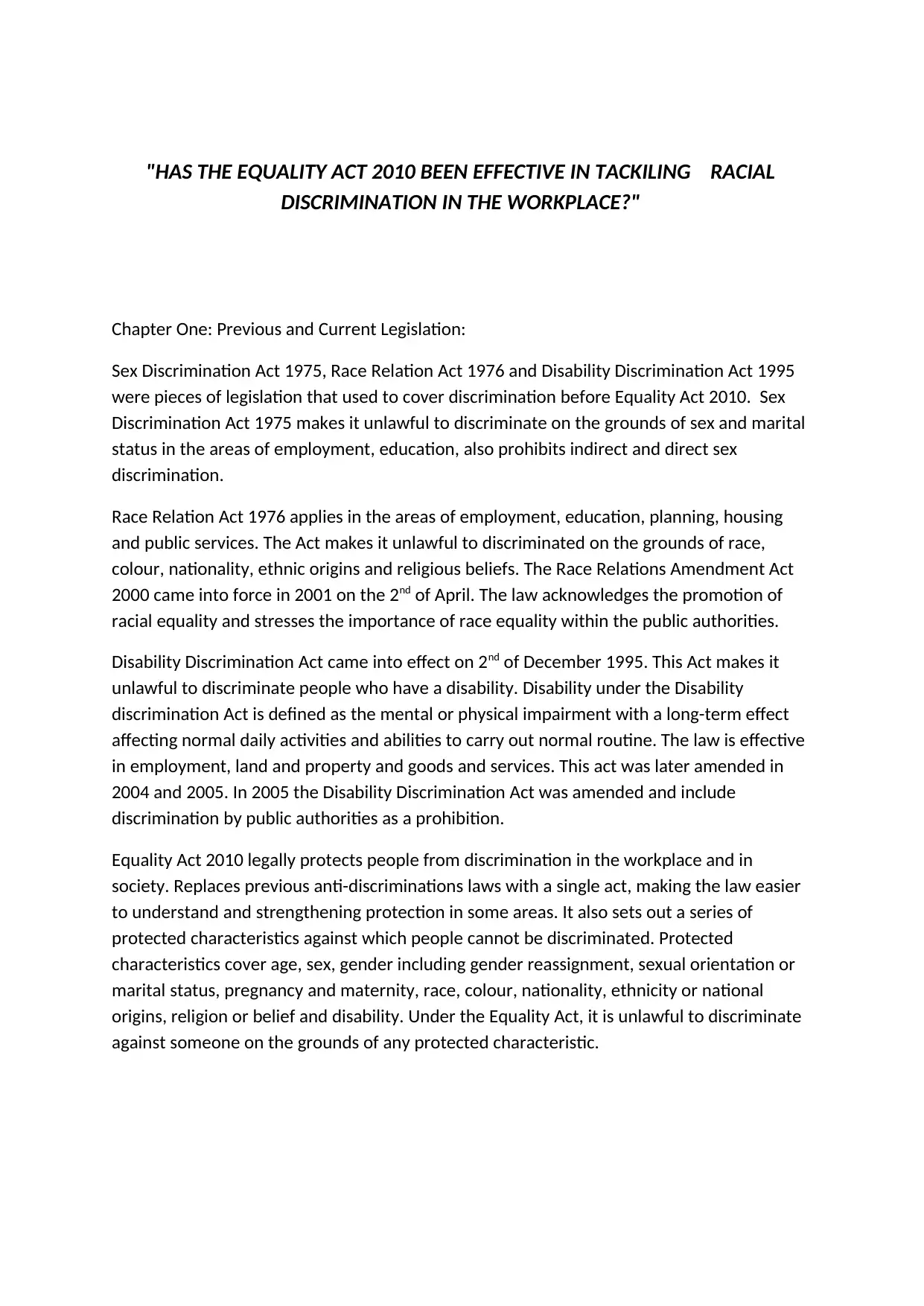
"HAS THE EQUALITY ACT 2010 BEEN EFFECTIVE IN TACKILING RACIAL
DISCRIMINATION IN THE WORKPLACE?"
Chapter One: Previous and Current Legislation:
Sex Discrimination Act 1975, Race Relation Act 1976 and Disability Discrimination Act 1995
were pieces of legislation that used to cover discrimination before Equality Act 2010. Sex
Discrimination Act 1975 makes it unlawful to discriminate on the grounds of sex and marital
status in the areas of employment, education, also prohibits indirect and direct sex
discrimination.
Race Relation Act 1976 applies in the areas of employment, education, planning, housing
and public services. The Act makes it unlawful to discriminated on the grounds of race,
colour, nationality, ethnic origins and religious beliefs. The Race Relations Amendment Act
2000 came into force in 2001 on the 2nd of April. The law acknowledges the promotion of
racial equality and stresses the importance of race equality within the public authorities.
Disability Discrimination Act came into effect on 2nd of December 1995. This Act makes it
unlawful to discriminate people who have a disability. Disability under the Disability
discrimination Act is defined as the mental or physical impairment with a long-term effect
affecting normal daily activities and abilities to carry out normal routine. The law is effective
in employment, land and property and goods and services. This act was later amended in
2004 and 2005. In 2005 the Disability Discrimination Act was amended and include
discrimination by public authorities as a prohibition.
Equality Act 2010 legally protects people from discrimination in the workplace and in
society. Replaces previous anti-discriminations laws with a single act, making the law easier
to understand and strengthening protection in some areas. It also sets out a series of
protected characteristics against which people cannot be discriminated. Protected
characteristics cover age, sex, gender including gender reassignment, sexual orientation or
marital status, pregnancy and maternity, race, colour, nationality, ethnicity or national
origins, religion or belief and disability. Under the Equality Act, it is unlawful to discriminate
against someone on the grounds of any protected characteristic.
DISCRIMINATION IN THE WORKPLACE?"
Chapter One: Previous and Current Legislation:
Sex Discrimination Act 1975, Race Relation Act 1976 and Disability Discrimination Act 1995
were pieces of legislation that used to cover discrimination before Equality Act 2010. Sex
Discrimination Act 1975 makes it unlawful to discriminate on the grounds of sex and marital
status in the areas of employment, education, also prohibits indirect and direct sex
discrimination.
Race Relation Act 1976 applies in the areas of employment, education, planning, housing
and public services. The Act makes it unlawful to discriminated on the grounds of race,
colour, nationality, ethnic origins and religious beliefs. The Race Relations Amendment Act
2000 came into force in 2001 on the 2nd of April. The law acknowledges the promotion of
racial equality and stresses the importance of race equality within the public authorities.
Disability Discrimination Act came into effect on 2nd of December 1995. This Act makes it
unlawful to discriminate people who have a disability. Disability under the Disability
discrimination Act is defined as the mental or physical impairment with a long-term effect
affecting normal daily activities and abilities to carry out normal routine. The law is effective
in employment, land and property and goods and services. This act was later amended in
2004 and 2005. In 2005 the Disability Discrimination Act was amended and include
discrimination by public authorities as a prohibition.
Equality Act 2010 legally protects people from discrimination in the workplace and in
society. Replaces previous anti-discriminations laws with a single act, making the law easier
to understand and strengthening protection in some areas. It also sets out a series of
protected characteristics against which people cannot be discriminated. Protected
characteristics cover age, sex, gender including gender reassignment, sexual orientation or
marital status, pregnancy and maternity, race, colour, nationality, ethnicity or national
origins, religion or belief and disability. Under the Equality Act, it is unlawful to discriminate
against someone on the grounds of any protected characteristic.
⊘ This is a preview!⊘
Do you want full access?
Subscribe today to unlock all pages.

Trusted by 1+ million students worldwide
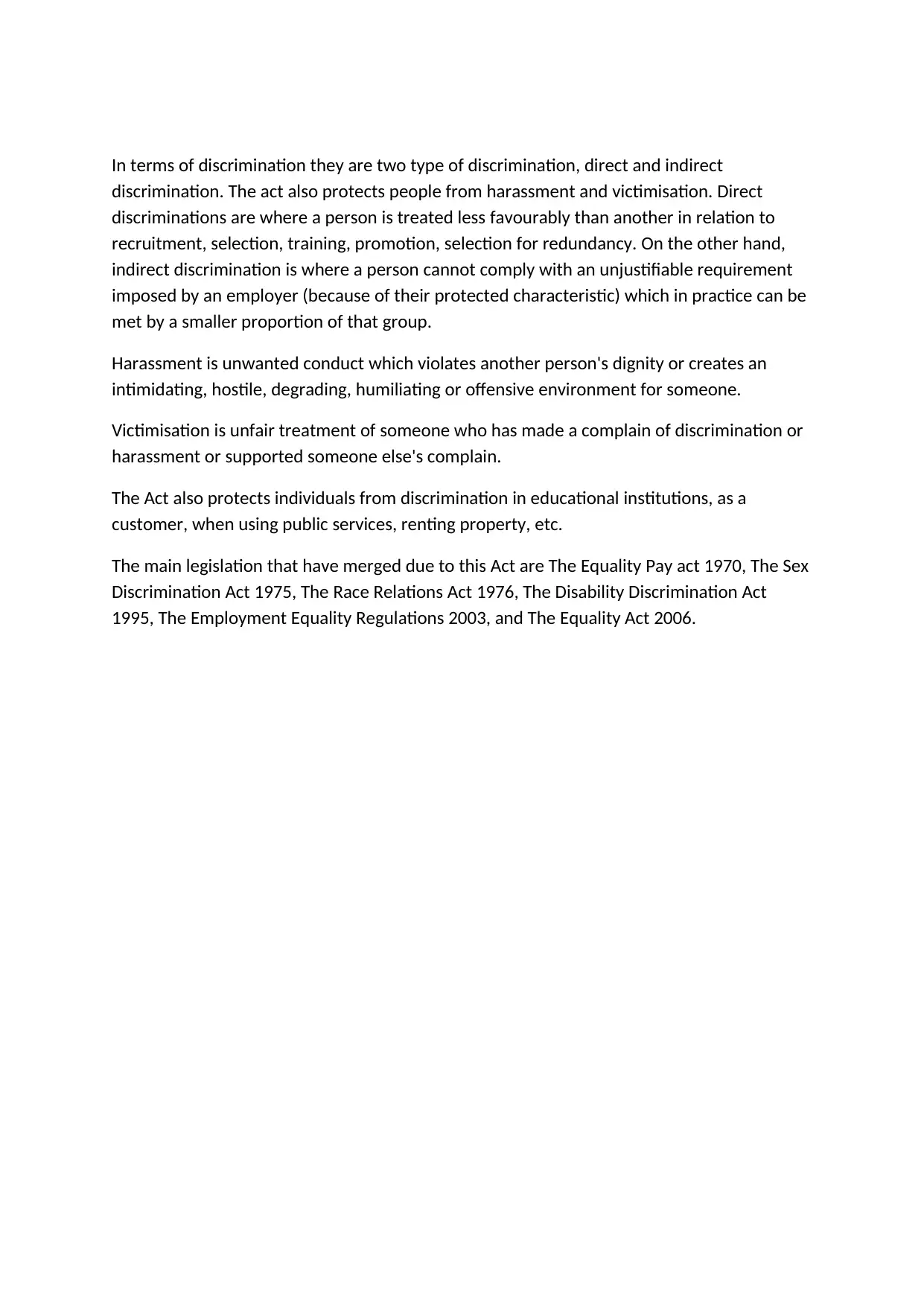
In terms of discrimination they are two type of discrimination, direct and indirect
discrimination. The act also protects people from harassment and victimisation. Direct
discriminations are where a person is treated less favourably than another in relation to
recruitment, selection, training, promotion, selection for redundancy. On the other hand,
indirect discrimination is where a person cannot comply with an unjustifiable requirement
imposed by an employer (because of their protected characteristic) which in practice can be
met by a smaller proportion of that group.
Harassment is unwanted conduct which violates another person's dignity or creates an
intimidating, hostile, degrading, humiliating or offensive environment for someone.
Victimisation is unfair treatment of someone who has made a complain of discrimination or
harassment or supported someone else's complain.
The Act also protects individuals from discrimination in educational institutions, as a
customer, when using public services, renting property, etc.
The main legislation that have merged due to this Act are The Equality Pay act 1970, The Sex
Discrimination Act 1975, The Race Relations Act 1976, The Disability Discrimination Act
1995, The Employment Equality Regulations 2003, and The Equality Act 2006.
discrimination. The act also protects people from harassment and victimisation. Direct
discriminations are where a person is treated less favourably than another in relation to
recruitment, selection, training, promotion, selection for redundancy. On the other hand,
indirect discrimination is where a person cannot comply with an unjustifiable requirement
imposed by an employer (because of their protected characteristic) which in practice can be
met by a smaller proportion of that group.
Harassment is unwanted conduct which violates another person's dignity or creates an
intimidating, hostile, degrading, humiliating or offensive environment for someone.
Victimisation is unfair treatment of someone who has made a complain of discrimination or
harassment or supported someone else's complain.
The Act also protects individuals from discrimination in educational institutions, as a
customer, when using public services, renting property, etc.
The main legislation that have merged due to this Act are The Equality Pay act 1970, The Sex
Discrimination Act 1975, The Race Relations Act 1976, The Disability Discrimination Act
1995, The Employment Equality Regulations 2003, and The Equality Act 2006.
Paraphrase This Document
Need a fresh take? Get an instant paraphrase of this document with our AI Paraphraser
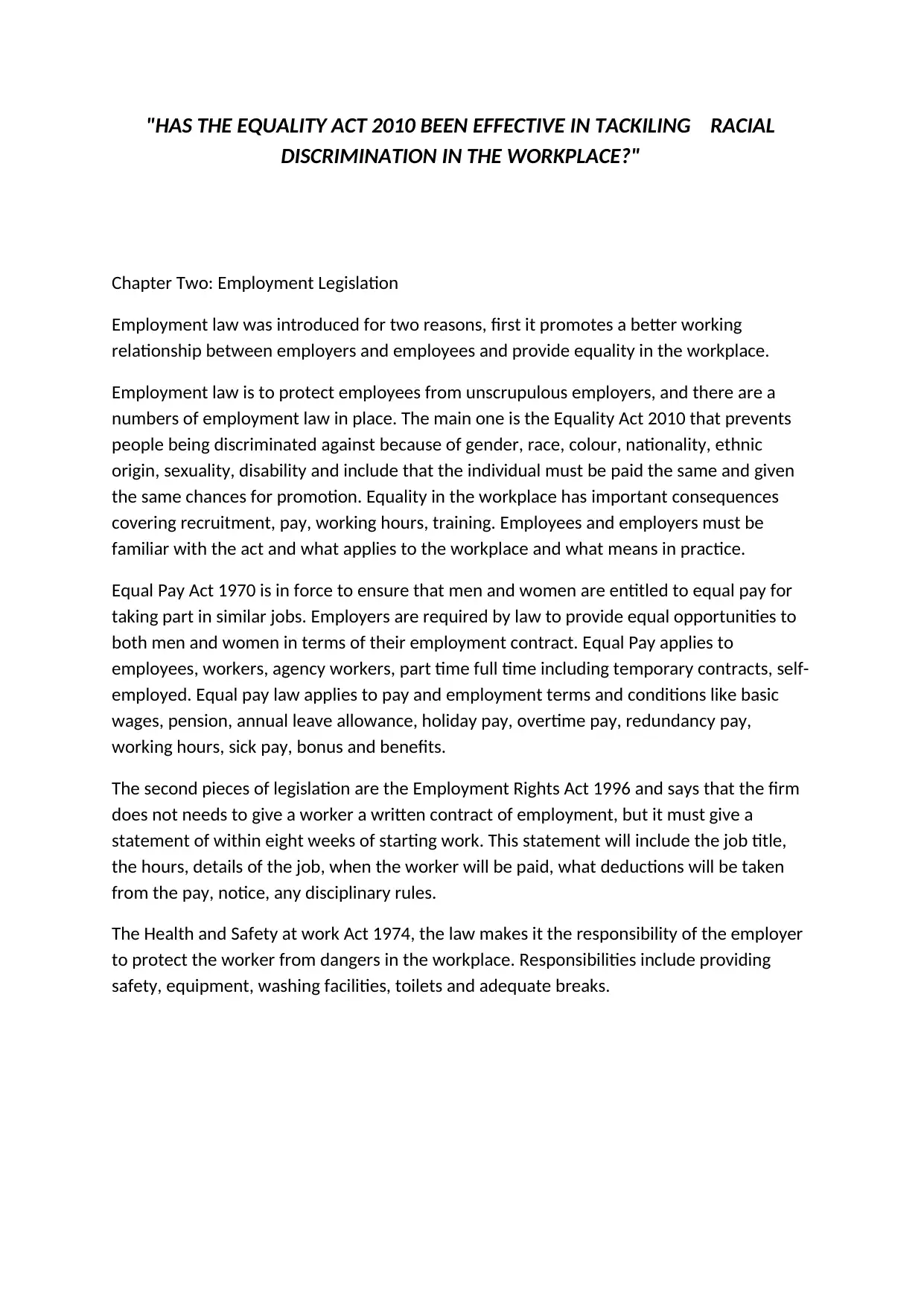
"HAS THE EQUALITY ACT 2010 BEEN EFFECTIVE IN TACKILING RACIAL
DISCRIMINATION IN THE WORKPLACE?"
Chapter Two: Employment Legislation
Employment law was introduced for two reasons, first it promotes a better working
relationship between employers and employees and provide equality in the workplace.
Employment law is to protect employees from unscrupulous employers, and there are a
numbers of employment law in place. The main one is the Equality Act 2010 that prevents
people being discriminated against because of gender, race, colour, nationality, ethnic
origin, sexuality, disability and include that the individual must be paid the same and given
the same chances for promotion. Equality in the workplace has important consequences
covering recruitment, pay, working hours, training. Employees and employers must be
familiar with the act and what applies to the workplace and what means in practice.
Equal Pay Act 1970 is in force to ensure that men and women are entitled to equal pay for
taking part in similar jobs. Employers are required by law to provide equal opportunities to
both men and women in terms of their employment contract. Equal Pay applies to
employees, workers, agency workers, part time full time including temporary contracts, self-
employed. Equal pay law applies to pay and employment terms and conditions like basic
wages, pension, annual leave allowance, holiday pay, overtime pay, redundancy pay,
working hours, sick pay, bonus and benefits.
The second pieces of legislation are the Employment Rights Act 1996 and says that the firm
does not needs to give a worker a written contract of employment, but it must give a
statement of within eight weeks of starting work. This statement will include the job title,
the hours, details of the job, when the worker will be paid, what deductions will be taken
from the pay, notice, any disciplinary rules.
The Health and Safety at work Act 1974, the law makes it the responsibility of the employer
to protect the worker from dangers in the workplace. Responsibilities include providing
safety, equipment, washing facilities, toilets and adequate breaks.
DISCRIMINATION IN THE WORKPLACE?"
Chapter Two: Employment Legislation
Employment law was introduced for two reasons, first it promotes a better working
relationship between employers and employees and provide equality in the workplace.
Employment law is to protect employees from unscrupulous employers, and there are a
numbers of employment law in place. The main one is the Equality Act 2010 that prevents
people being discriminated against because of gender, race, colour, nationality, ethnic
origin, sexuality, disability and include that the individual must be paid the same and given
the same chances for promotion. Equality in the workplace has important consequences
covering recruitment, pay, working hours, training. Employees and employers must be
familiar with the act and what applies to the workplace and what means in practice.
Equal Pay Act 1970 is in force to ensure that men and women are entitled to equal pay for
taking part in similar jobs. Employers are required by law to provide equal opportunities to
both men and women in terms of their employment contract. Equal Pay applies to
employees, workers, agency workers, part time full time including temporary contracts, self-
employed. Equal pay law applies to pay and employment terms and conditions like basic
wages, pension, annual leave allowance, holiday pay, overtime pay, redundancy pay,
working hours, sick pay, bonus and benefits.
The second pieces of legislation are the Employment Rights Act 1996 and says that the firm
does not needs to give a worker a written contract of employment, but it must give a
statement of within eight weeks of starting work. This statement will include the job title,
the hours, details of the job, when the worker will be paid, what deductions will be taken
from the pay, notice, any disciplinary rules.
The Health and Safety at work Act 1974, the law makes it the responsibility of the employer
to protect the worker from dangers in the workplace. Responsibilities include providing
safety, equipment, washing facilities, toilets and adequate breaks.
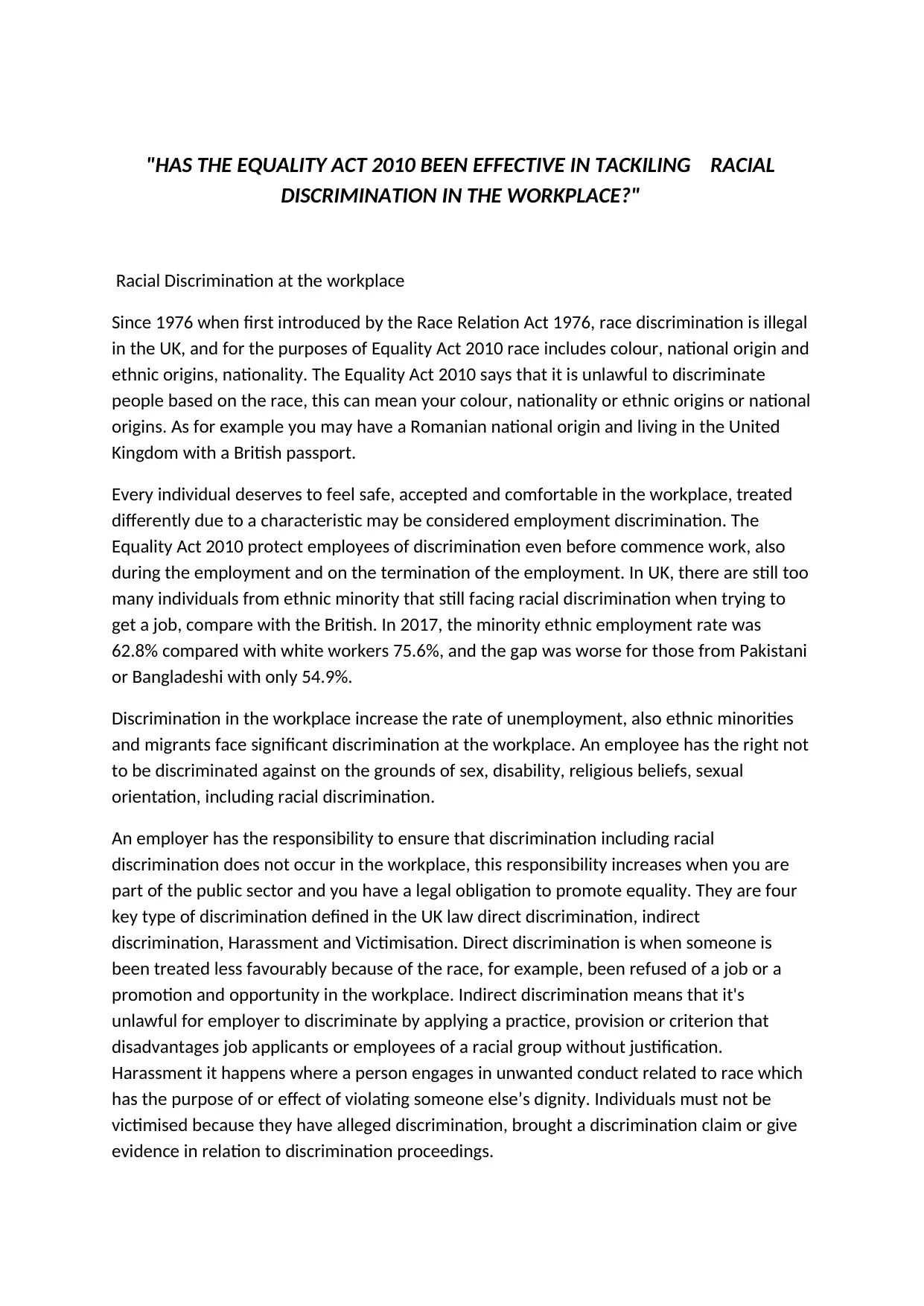
"HAS THE EQUALITY ACT 2010 BEEN EFFECTIVE IN TACKILING RACIAL
DISCRIMINATION IN THE WORKPLACE?"
Racial Discrimination at the workplace
Since 1976 when first introduced by the Race Relation Act 1976, race discrimination is illegal
in the UK, and for the purposes of Equality Act 2010 race includes colour, national origin and
ethnic origins, nationality. The Equality Act 2010 says that it is unlawful to discriminate
people based on the race, this can mean your colour, nationality or ethnic origins or national
origins. As for example you may have a Romanian national origin and living in the United
Kingdom with a British passport.
Every individual deserves to feel safe, accepted and comfortable in the workplace, treated
differently due to a characteristic may be considered employment discrimination. The
Equality Act 2010 protect employees of discrimination even before commence work, also
during the employment and on the termination of the employment. In UK, there are still too
many individuals from ethnic minority that still facing racial discrimination when trying to
get a job, compare with the British. In 2017, the minority ethnic employment rate was
62.8% compared with white workers 75.6%, and the gap was worse for those from Pakistani
or Bangladeshi with only 54.9%.
Discrimination in the workplace increase the rate of unemployment, also ethnic minorities
and migrants face significant discrimination at the workplace. An employee has the right not
to be discriminated against on the grounds of sex, disability, religious beliefs, sexual
orientation, including racial discrimination.
An employer has the responsibility to ensure that discrimination including racial
discrimination does not occur in the workplace, this responsibility increases when you are
part of the public sector and you have a legal obligation to promote equality. They are four
key type of discrimination defined in the UK law direct discrimination, indirect
discrimination, Harassment and Victimisation. Direct discrimination is when someone is
been treated less favourably because of the race, for example, been refused of a job or a
promotion and opportunity in the workplace. Indirect discrimination means that it's
unlawful for employer to discriminate by applying a practice, provision or criterion that
disadvantages job applicants or employees of a racial group without justification.
Harassment it happens where a person engages in unwanted conduct related to race which
has the purpose of or effect of violating someone else’s dignity. Individuals must not be
victimised because they have alleged discrimination, brought a discrimination claim or give
evidence in relation to discrimination proceedings.
DISCRIMINATION IN THE WORKPLACE?"
Racial Discrimination at the workplace
Since 1976 when first introduced by the Race Relation Act 1976, race discrimination is illegal
in the UK, and for the purposes of Equality Act 2010 race includes colour, national origin and
ethnic origins, nationality. The Equality Act 2010 says that it is unlawful to discriminate
people based on the race, this can mean your colour, nationality or ethnic origins or national
origins. As for example you may have a Romanian national origin and living in the United
Kingdom with a British passport.
Every individual deserves to feel safe, accepted and comfortable in the workplace, treated
differently due to a characteristic may be considered employment discrimination. The
Equality Act 2010 protect employees of discrimination even before commence work, also
during the employment and on the termination of the employment. In UK, there are still too
many individuals from ethnic minority that still facing racial discrimination when trying to
get a job, compare with the British. In 2017, the minority ethnic employment rate was
62.8% compared with white workers 75.6%, and the gap was worse for those from Pakistani
or Bangladeshi with only 54.9%.
Discrimination in the workplace increase the rate of unemployment, also ethnic minorities
and migrants face significant discrimination at the workplace. An employee has the right not
to be discriminated against on the grounds of sex, disability, religious beliefs, sexual
orientation, including racial discrimination.
An employer has the responsibility to ensure that discrimination including racial
discrimination does not occur in the workplace, this responsibility increases when you are
part of the public sector and you have a legal obligation to promote equality. They are four
key type of discrimination defined in the UK law direct discrimination, indirect
discrimination, Harassment and Victimisation. Direct discrimination is when someone is
been treated less favourably because of the race, for example, been refused of a job or a
promotion and opportunity in the workplace. Indirect discrimination means that it's
unlawful for employer to discriminate by applying a practice, provision or criterion that
disadvantages job applicants or employees of a racial group without justification.
Harassment it happens where a person engages in unwanted conduct related to race which
has the purpose of or effect of violating someone else’s dignity. Individuals must not be
victimised because they have alleged discrimination, brought a discrimination claim or give
evidence in relation to discrimination proceedings.
⊘ This is a preview!⊘
Do you want full access?
Subscribe today to unlock all pages.

Trusted by 1+ million students worldwide
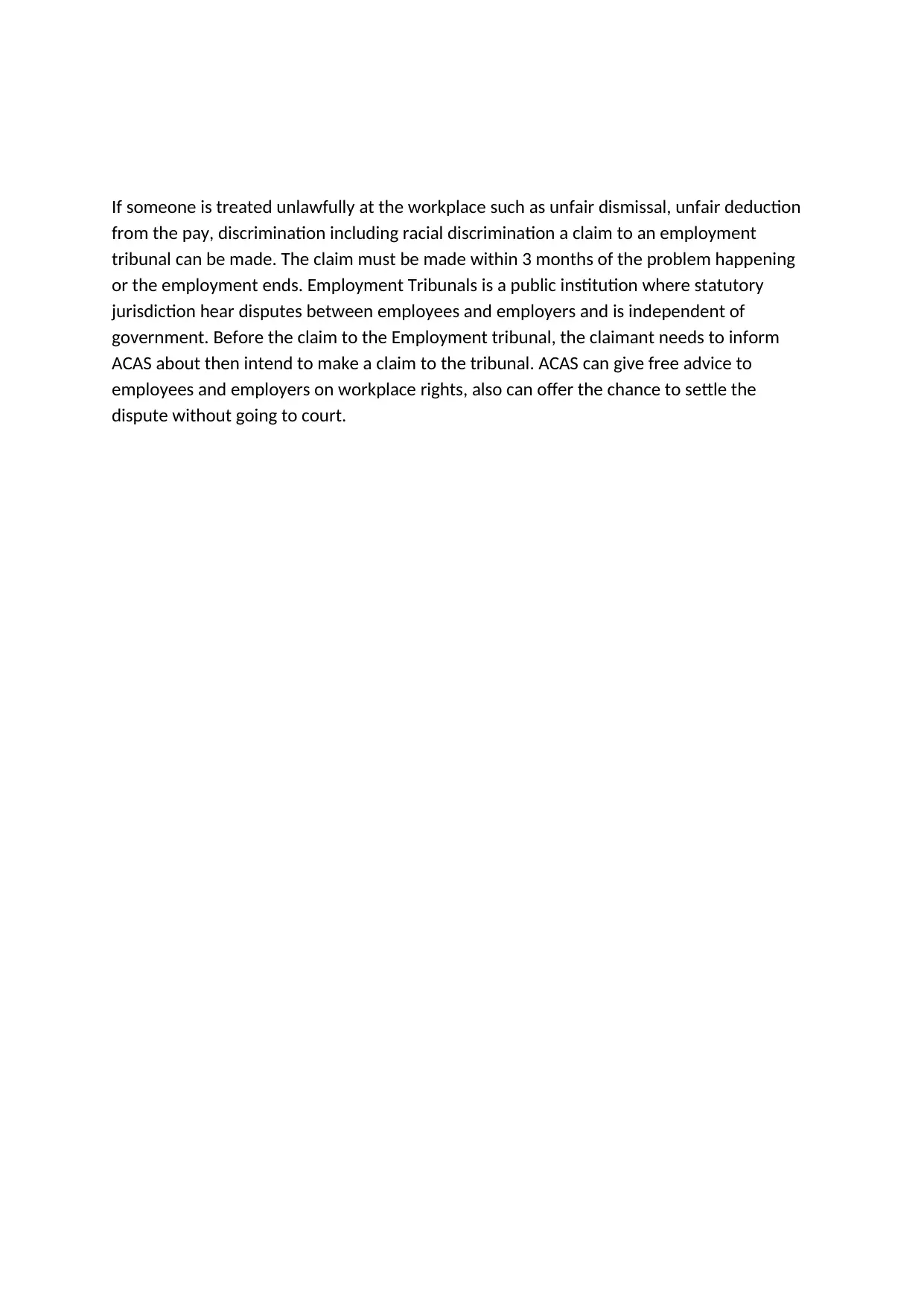
If someone is treated unlawfully at the workplace such as unfair dismissal, unfair deduction
from the pay, discrimination including racial discrimination a claim to an employment
tribunal can be made. The claim must be made within 3 months of the problem happening
or the employment ends. Employment Tribunals is a public institution where statutory
jurisdiction hear disputes between employees and employers and is independent of
government. Before the claim to the Employment tribunal, the claimant needs to inform
ACAS about then intend to make a claim to the tribunal. ACAS can give free advice to
employees and employers on workplace rights, also can offer the chance to settle the
dispute without going to court.
from the pay, discrimination including racial discrimination a claim to an employment
tribunal can be made. The claim must be made within 3 months of the problem happening
or the employment ends. Employment Tribunals is a public institution where statutory
jurisdiction hear disputes between employees and employers and is independent of
government. Before the claim to the Employment tribunal, the claimant needs to inform
ACAS about then intend to make a claim to the tribunal. ACAS can give free advice to
employees and employers on workplace rights, also can offer the chance to settle the
dispute without going to court.
Paraphrase This Document
Need a fresh take? Get an instant paraphrase of this document with our AI Paraphraser
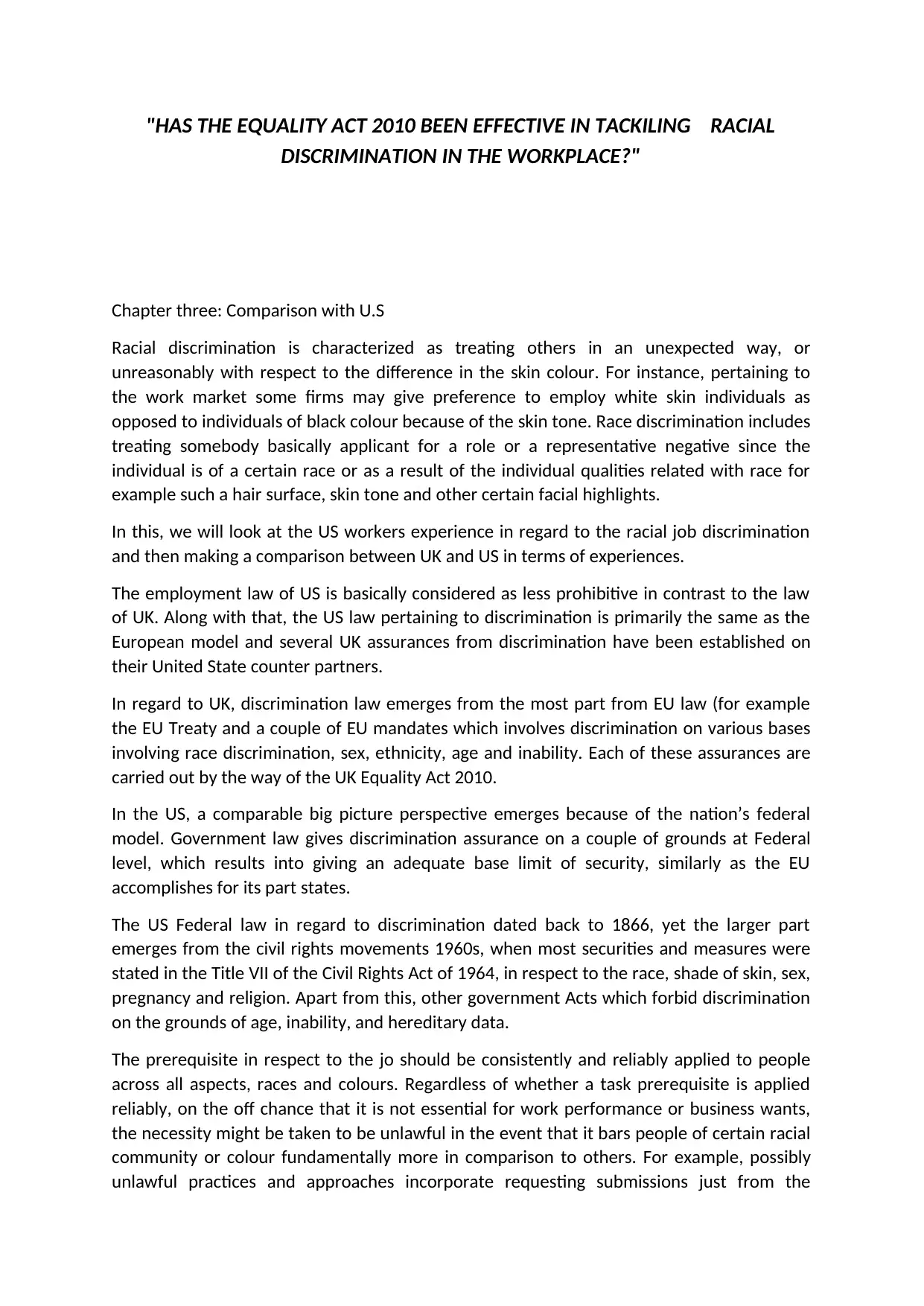
"HAS THE EQUALITY ACT 2010 BEEN EFFECTIVE IN TACKILING RACIAL
DISCRIMINATION IN THE WORKPLACE?"
Chapter three: Comparison with U.S
Racial discrimination is characterized as treating others in an unexpected way, or
unreasonably with respect to the difference in the skin colour. For instance, pertaining to
the work market some firms may give preference to employ white skin individuals as
opposed to individuals of black colour because of the skin tone. Race discrimination includes
treating somebody basically applicant for a role or a representative negative since the
individual is of a certain race or as a result of the individual qualities related with race for
example such a hair surface, skin tone and other certain facial highlights.
In this, we will look at the US workers experience in regard to the racial job discrimination
and then making a comparison between UK and US in terms of experiences.
The employment law of US is basically considered as less prohibitive in contrast to the law
of UK. Along with that, the US law pertaining to discrimination is primarily the same as the
European model and several UK assurances from discrimination have been established on
their United State counter partners.
In regard to UK, discrimination law emerges from the most part from EU law (for example
the EU Treaty and a couple of EU mandates which involves discrimination on various bases
involving race discrimination, sex, ethnicity, age and inability. Each of these assurances are
carried out by the way of the UK Equality Act 2010.
In the US, a comparable big picture perspective emerges because of the nation’s federal
model. Government law gives discrimination assurance on a couple of grounds at Federal
level, which results into giving an adequate base limit of security, similarly as the EU
accomplishes for its part states.
The US Federal law in regard to discrimination dated back to 1866, yet the larger part
emerges from the civil rights movements 1960s, when most securities and measures were
stated in the Title VII of the Civil Rights Act of 1964, in respect to the race, shade of skin, sex,
pregnancy and religion. Apart from this, other government Acts which forbid discrimination
on the grounds of age, inability, and hereditary data.
The prerequisite in respect to the jo should be consistently and reliably applied to people
across all aspects, races and colours. Regardless of whether a task prerequisite is applied
reliably, on the off chance that it is not essential for work performance or business wants,
the necessity might be taken to be unlawful in the event that it bars people of certain racial
community or colour fundamentally more in comparison to others. For example, possibly
unlawful practices and approaches incorporate requesting submissions just from the
DISCRIMINATION IN THE WORKPLACE?"
Chapter three: Comparison with U.S
Racial discrimination is characterized as treating others in an unexpected way, or
unreasonably with respect to the difference in the skin colour. For instance, pertaining to
the work market some firms may give preference to employ white skin individuals as
opposed to individuals of black colour because of the skin tone. Race discrimination includes
treating somebody basically applicant for a role or a representative negative since the
individual is of a certain race or as a result of the individual qualities related with race for
example such a hair surface, skin tone and other certain facial highlights.
In this, we will look at the US workers experience in regard to the racial job discrimination
and then making a comparison between UK and US in terms of experiences.
The employment law of US is basically considered as less prohibitive in contrast to the law
of UK. Along with that, the US law pertaining to discrimination is primarily the same as the
European model and several UK assurances from discrimination have been established on
their United State counter partners.
In regard to UK, discrimination law emerges from the most part from EU law (for example
the EU Treaty and a couple of EU mandates which involves discrimination on various bases
involving race discrimination, sex, ethnicity, age and inability. Each of these assurances are
carried out by the way of the UK Equality Act 2010.
In the US, a comparable big picture perspective emerges because of the nation’s federal
model. Government law gives discrimination assurance on a couple of grounds at Federal
level, which results into giving an adequate base limit of security, similarly as the EU
accomplishes for its part states.
The US Federal law in regard to discrimination dated back to 1866, yet the larger part
emerges from the civil rights movements 1960s, when most securities and measures were
stated in the Title VII of the Civil Rights Act of 1964, in respect to the race, shade of skin, sex,
pregnancy and religion. Apart from this, other government Acts which forbid discrimination
on the grounds of age, inability, and hereditary data.
The prerequisite in respect to the jo should be consistently and reliably applied to people
across all aspects, races and colours. Regardless of whether a task prerequisite is applied
reliably, on the off chance that it is not essential for work performance or business wants,
the necessity might be taken to be unlawful in the event that it bars people of certain racial
community or colour fundamentally more in comparison to others. For example, possibly
unlawful practices and approaches incorporate requesting submissions just from the
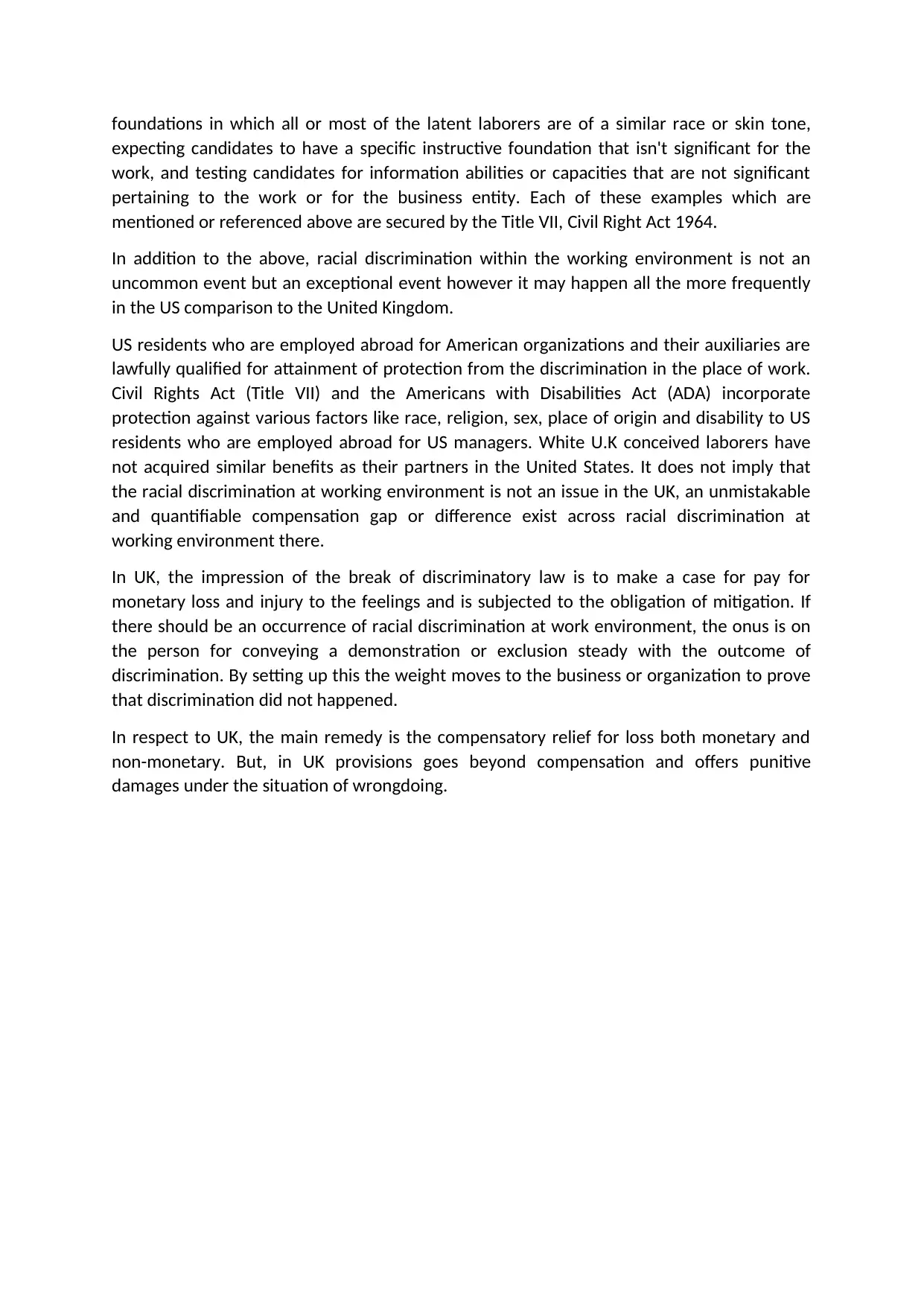
foundations in which all or most of the latent laborers are of a similar race or skin tone,
expecting candidates to have a specific instructive foundation that isn't significant for the
work, and testing candidates for information abilities or capacities that are not significant
pertaining to the work or for the business entity. Each of these examples which are
mentioned or referenced above are secured by the Title VII, Civil Right Act 1964.
In addition to the above, racial discrimination within the working environment is not an
uncommon event but an exceptional event however it may happen all the more frequently
in the US comparison to the United Kingdom.
US residents who are employed abroad for American organizations and their auxiliaries are
lawfully qualified for attainment of protection from the discrimination in the place of work.
Civil Rights Act (Title VII) and the Americans with Disabilities Act (ADA) incorporate
protection against various factors like race, religion, sex, place of origin and disability to US
residents who are employed abroad for US managers. White U.K conceived laborers have
not acquired similar benefits as their partners in the United States. It does not imply that
the racial discrimination at working environment is not an issue in the UK, an unmistakable
and quantifiable compensation gap or difference exist across racial discrimination at
working environment there.
In UK, the impression of the break of discriminatory law is to make a case for pay for
monetary loss and injury to the feelings and is subjected to the obligation of mitigation. If
there should be an occurrence of racial discrimination at work environment, the onus is on
the person for conveying a demonstration or exclusion steady with the outcome of
discrimination. By setting up this the weight moves to the business or organization to prove
that discrimination did not happened.
In respect to UK, the main remedy is the compensatory relief for loss both monetary and
non-monetary. But, in UK provisions goes beyond compensation and offers punitive
damages under the situation of wrongdoing.
expecting candidates to have a specific instructive foundation that isn't significant for the
work, and testing candidates for information abilities or capacities that are not significant
pertaining to the work or for the business entity. Each of these examples which are
mentioned or referenced above are secured by the Title VII, Civil Right Act 1964.
In addition to the above, racial discrimination within the working environment is not an
uncommon event but an exceptional event however it may happen all the more frequently
in the US comparison to the United Kingdom.
US residents who are employed abroad for American organizations and their auxiliaries are
lawfully qualified for attainment of protection from the discrimination in the place of work.
Civil Rights Act (Title VII) and the Americans with Disabilities Act (ADA) incorporate
protection against various factors like race, religion, sex, place of origin and disability to US
residents who are employed abroad for US managers. White U.K conceived laborers have
not acquired similar benefits as their partners in the United States. It does not imply that
the racial discrimination at working environment is not an issue in the UK, an unmistakable
and quantifiable compensation gap or difference exist across racial discrimination at
working environment there.
In UK, the impression of the break of discriminatory law is to make a case for pay for
monetary loss and injury to the feelings and is subjected to the obligation of mitigation. If
there should be an occurrence of racial discrimination at work environment, the onus is on
the person for conveying a demonstration or exclusion steady with the outcome of
discrimination. By setting up this the weight moves to the business or organization to prove
that discrimination did not happened.
In respect to UK, the main remedy is the compensatory relief for loss both monetary and
non-monetary. But, in UK provisions goes beyond compensation and offers punitive
damages under the situation of wrongdoing.
⊘ This is a preview!⊘
Do you want full access?
Subscribe today to unlock all pages.

Trusted by 1+ million students worldwide
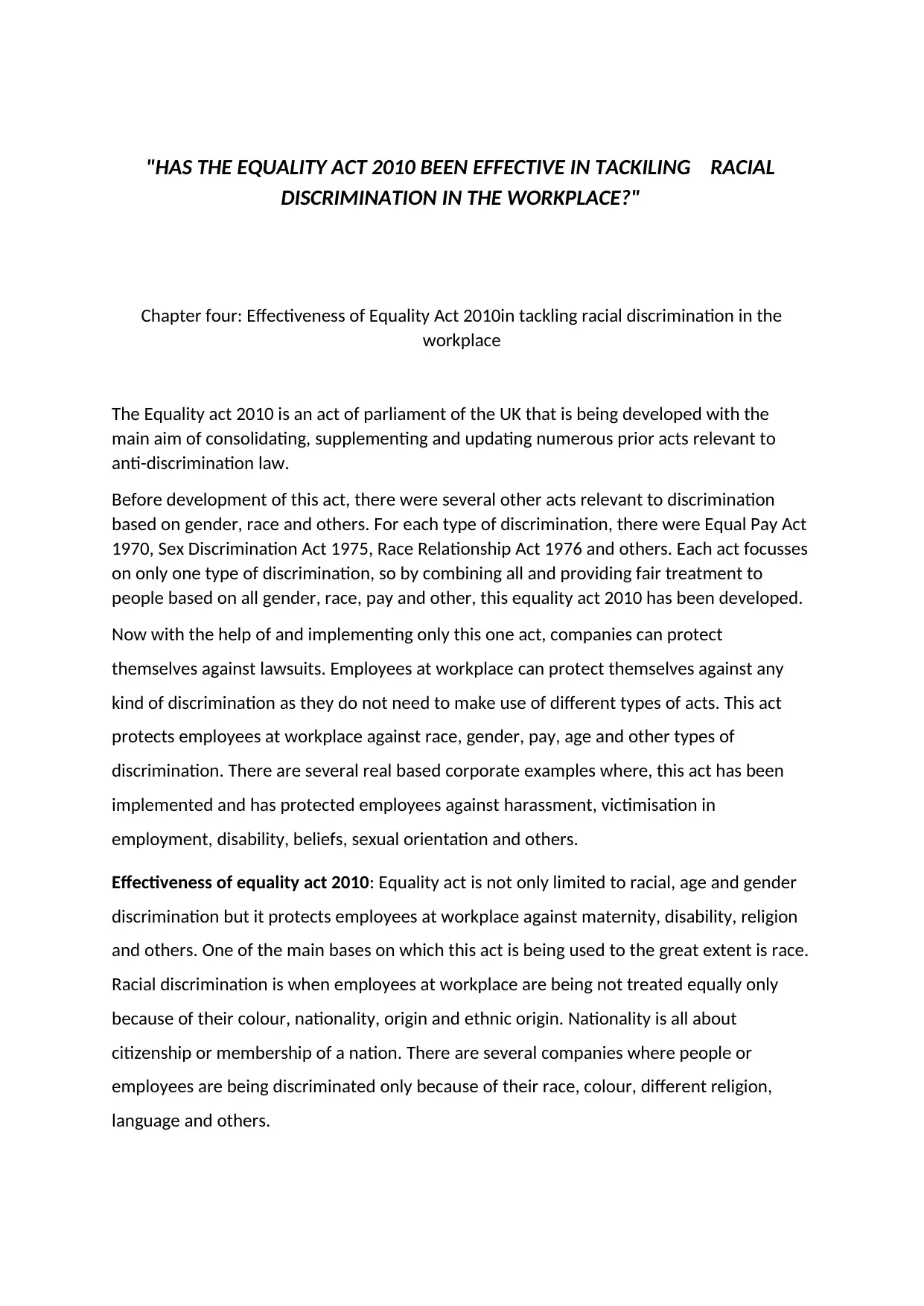
"HAS THE EQUALITY ACT 2010 BEEN EFFECTIVE IN TACKILING RACIAL
DISCRIMINATION IN THE WORKPLACE?"
Chapter four: Effectiveness of Equality Act 2010in tackling racial discrimination in the
workplace
The Equality act 2010 is an act of parliament of the UK that is being developed with the
main aim of consolidating, supplementing and updating numerous prior acts relevant to
anti-discrimination law.
Before development of this act, there were several other acts relevant to discrimination
based on gender, race and others. For each type of discrimination, there were Equal Pay Act
1970, Sex Discrimination Act 1975, Race Relationship Act 1976 and others. Each act focusses
on only one type of discrimination, so by combining all and providing fair treatment to
people based on all gender, race, pay and other, this equality act 2010 has been developed.
Now with the help of and implementing only this one act, companies can protect
themselves against lawsuits. Employees at workplace can protect themselves against any
kind of discrimination as they do not need to make use of different types of acts. This act
protects employees at workplace against race, gender, pay, age and other types of
discrimination. There are several real based corporate examples where, this act has been
implemented and has protected employees against harassment, victimisation in
employment, disability, beliefs, sexual orientation and others.
Effectiveness of equality act 2010: Equality act is not only limited to racial, age and gender
discrimination but it protects employees at workplace against maternity, disability, religion
and others. One of the main bases on which this act is being used to the great extent is race.
Racial discrimination is when employees at workplace are being not treated equally only
because of their colour, nationality, origin and ethnic origin. Nationality is all about
citizenship or membership of a nation. There are several companies where people or
employees are being discriminated only because of their race, colour, different religion,
language and others.
DISCRIMINATION IN THE WORKPLACE?"
Chapter four: Effectiveness of Equality Act 2010in tackling racial discrimination in the
workplace
The Equality act 2010 is an act of parliament of the UK that is being developed with the
main aim of consolidating, supplementing and updating numerous prior acts relevant to
anti-discrimination law.
Before development of this act, there were several other acts relevant to discrimination
based on gender, race and others. For each type of discrimination, there were Equal Pay Act
1970, Sex Discrimination Act 1975, Race Relationship Act 1976 and others. Each act focusses
on only one type of discrimination, so by combining all and providing fair treatment to
people based on all gender, race, pay and other, this equality act 2010 has been developed.
Now with the help of and implementing only this one act, companies can protect
themselves against lawsuits. Employees at workplace can protect themselves against any
kind of discrimination as they do not need to make use of different types of acts. This act
protects employees at workplace against race, gender, pay, age and other types of
discrimination. There are several real based corporate examples where, this act has been
implemented and has protected employees against harassment, victimisation in
employment, disability, beliefs, sexual orientation and others.
Effectiveness of equality act 2010: Equality act is not only limited to racial, age and gender
discrimination but it protects employees at workplace against maternity, disability, religion
and others. One of the main bases on which this act is being used to the great extent is race.
Racial discrimination is when employees at workplace are being not treated equally only
because of their colour, nationality, origin and ethnic origin. Nationality is all about
citizenship or membership of a nation. There are several companies where people or
employees are being discriminated only because of their race, colour, different religion,
language and others.
Paraphrase This Document
Need a fresh take? Get an instant paraphrase of this document with our AI Paraphraser
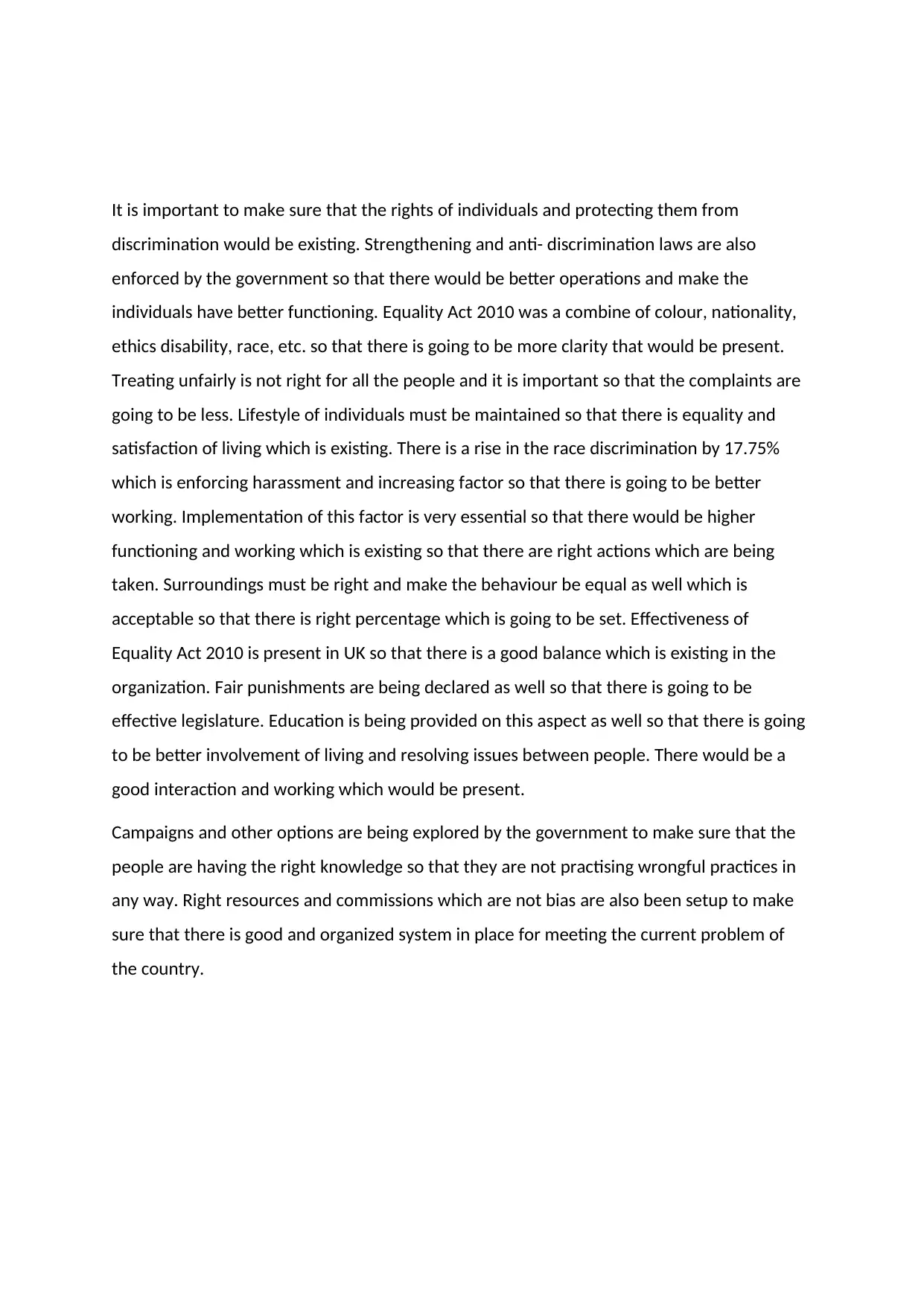
It is important to make sure that the rights of individuals and protecting them from
discrimination would be existing. Strengthening and anti- discrimination laws are also
enforced by the government so that there would be better operations and make the
individuals have better functioning. Equality Act 2010 was a combine of colour, nationality,
ethics disability, race, etc. so that there is going to be more clarity that would be present.
Treating unfairly is not right for all the people and it is important so that the complaints are
going to be less. Lifestyle of individuals must be maintained so that there is equality and
satisfaction of living which is existing. There is a rise in the race discrimination by 17.75%
which is enforcing harassment and increasing factor so that there is going to be better
working. Implementation of this factor is very essential so that there would be higher
functioning and working which is existing so that there are right actions which are being
taken. Surroundings must be right and make the behaviour be equal as well which is
acceptable so that there is right percentage which is going to be set. Effectiveness of
Equality Act 2010 is present in UK so that there is a good balance which is existing in the
organization. Fair punishments are being declared as well so that there is going to be
effective legislature. Education is being provided on this aspect as well so that there is going
to be better involvement of living and resolving issues between people. There would be a
good interaction and working which would be present.
Campaigns and other options are being explored by the government to make sure that the
people are having the right knowledge so that they are not practising wrongful practices in
any way. Right resources and commissions which are not bias are also been setup to make
sure that there is good and organized system in place for meeting the current problem of
the country.
discrimination would be existing. Strengthening and anti- discrimination laws are also
enforced by the government so that there would be better operations and make the
individuals have better functioning. Equality Act 2010 was a combine of colour, nationality,
ethics disability, race, etc. so that there is going to be more clarity that would be present.
Treating unfairly is not right for all the people and it is important so that the complaints are
going to be less. Lifestyle of individuals must be maintained so that there is equality and
satisfaction of living which is existing. There is a rise in the race discrimination by 17.75%
which is enforcing harassment and increasing factor so that there is going to be better
working. Implementation of this factor is very essential so that there would be higher
functioning and working which is existing so that there are right actions which are being
taken. Surroundings must be right and make the behaviour be equal as well which is
acceptable so that there is right percentage which is going to be set. Effectiveness of
Equality Act 2010 is present in UK so that there is a good balance which is existing in the
organization. Fair punishments are being declared as well so that there is going to be
effective legislature. Education is being provided on this aspect as well so that there is going
to be better involvement of living and resolving issues between people. There would be a
good interaction and working which would be present.
Campaigns and other options are being explored by the government to make sure that the
people are having the right knowledge so that they are not practising wrongful practices in
any way. Right resources and commissions which are not bias are also been setup to make
sure that there is good and organized system in place for meeting the current problem of
the country.
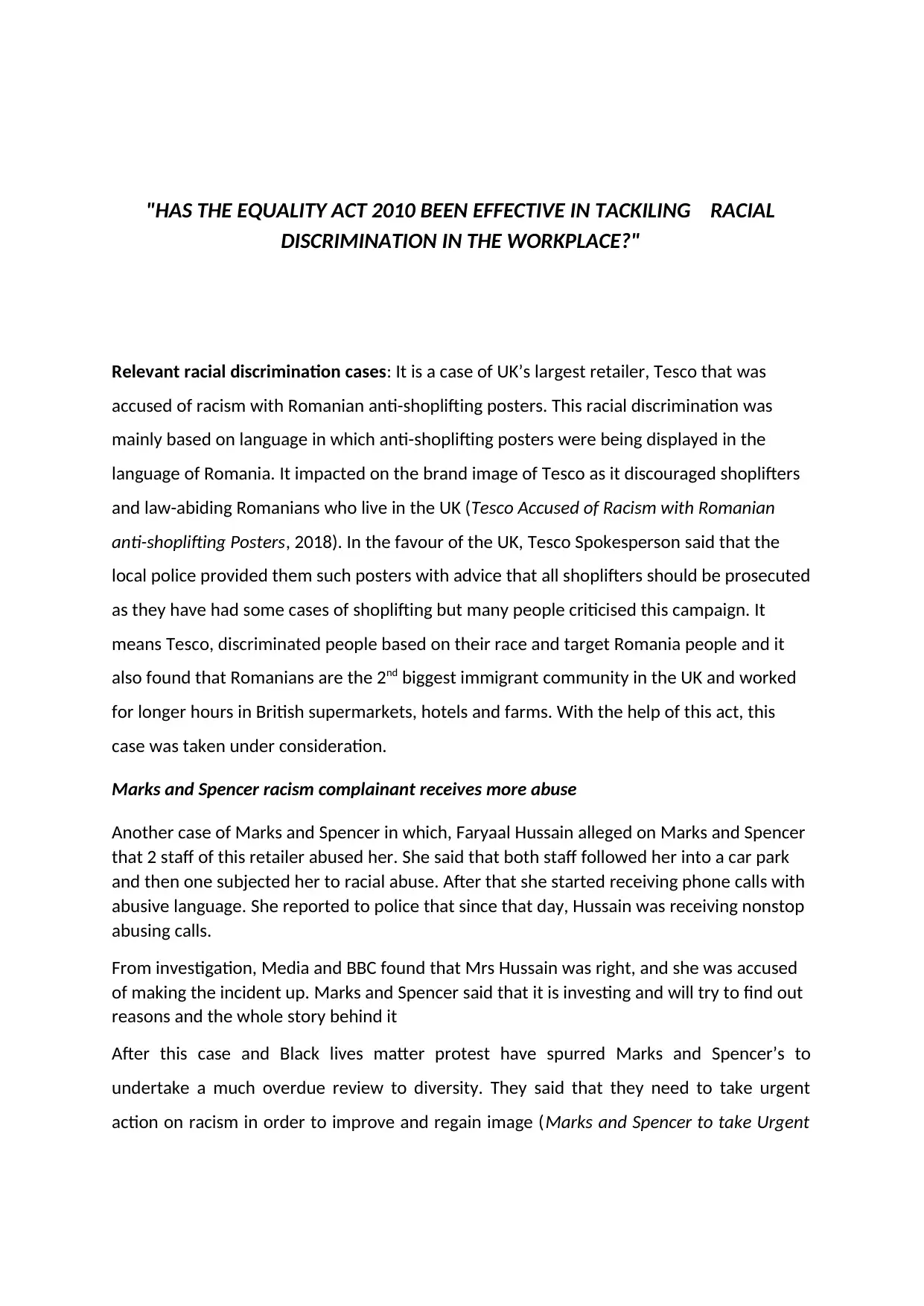
"HAS THE EQUALITY ACT 2010 BEEN EFFECTIVE IN TACKILING RACIAL
DISCRIMINATION IN THE WORKPLACE?"
Relevant racial discrimination cases: It is a case of UK’s largest retailer, Tesco that was
accused of racism with Romanian anti-shoplifting posters. This racial discrimination was
mainly based on language in which anti-shoplifting posters were being displayed in the
language of Romania. It impacted on the brand image of Tesco as it discouraged shoplifters
and law-abiding Romanians who live in the UK (Tesco Accused of Racism with Romanian
anti-shoplifting Posters, 2018). In the favour of the UK, Tesco Spokesperson said that the
local police provided them such posters with advice that all shoplifters should be prosecuted
as they have had some cases of shoplifting but many people criticised this campaign. It
means Tesco, discriminated people based on their race and target Romania people and it
also found that Romanians are the 2nd biggest immigrant community in the UK and worked
for longer hours in British supermarkets, hotels and farms. With the help of this act, this
case was taken under consideration.
Marks and Spencer racism complainant receives more abuse
Another case of Marks and Spencer in which, Faryaal Hussain alleged on Marks and Spencer
that 2 staff of this retailer abused her. She said that both staff followed her into a car park
and then one subjected her to racial abuse. After that she started receiving phone calls with
abusive language. She reported to police that since that day, Hussain was receiving nonstop
abusing calls.
From investigation, Media and BBC found that Mrs Hussain was right, and she was accused
of making the incident up. Marks and Spencer said that it is investing and will try to find out
reasons and the whole story behind it
After this case and Black lives matter protest have spurred Marks and Spencer’s to
undertake a much overdue review to diversity. They said that they need to take urgent
action on racism in order to improve and regain image (Marks and Spencer to take Urgent
DISCRIMINATION IN THE WORKPLACE?"
Relevant racial discrimination cases: It is a case of UK’s largest retailer, Tesco that was
accused of racism with Romanian anti-shoplifting posters. This racial discrimination was
mainly based on language in which anti-shoplifting posters were being displayed in the
language of Romania. It impacted on the brand image of Tesco as it discouraged shoplifters
and law-abiding Romanians who live in the UK (Tesco Accused of Racism with Romanian
anti-shoplifting Posters, 2018). In the favour of the UK, Tesco Spokesperson said that the
local police provided them such posters with advice that all shoplifters should be prosecuted
as they have had some cases of shoplifting but many people criticised this campaign. It
means Tesco, discriminated people based on their race and target Romania people and it
also found that Romanians are the 2nd biggest immigrant community in the UK and worked
for longer hours in British supermarkets, hotels and farms. With the help of this act, this
case was taken under consideration.
Marks and Spencer racism complainant receives more abuse
Another case of Marks and Spencer in which, Faryaal Hussain alleged on Marks and Spencer
that 2 staff of this retailer abused her. She said that both staff followed her into a car park
and then one subjected her to racial abuse. After that she started receiving phone calls with
abusive language. She reported to police that since that day, Hussain was receiving nonstop
abusing calls.
From investigation, Media and BBC found that Mrs Hussain was right, and she was accused
of making the incident up. Marks and Spencer said that it is investing and will try to find out
reasons and the whole story behind it
After this case and Black lives matter protest have spurred Marks and Spencer’s to
undertake a much overdue review to diversity. They said that they need to take urgent
action on racism in order to improve and regain image (Marks and Spencer to take Urgent
⊘ This is a preview!⊘
Do you want full access?
Subscribe today to unlock all pages.

Trusted by 1+ million students worldwide
1 out of 20
Related Documents
Your All-in-One AI-Powered Toolkit for Academic Success.
+13062052269
info@desklib.com
Available 24*7 on WhatsApp / Email
![[object Object]](/_next/static/media/star-bottom.7253800d.svg)
Unlock your academic potential
Copyright © 2020–2025 A2Z Services. All Rights Reserved. Developed and managed by ZUCOL.





